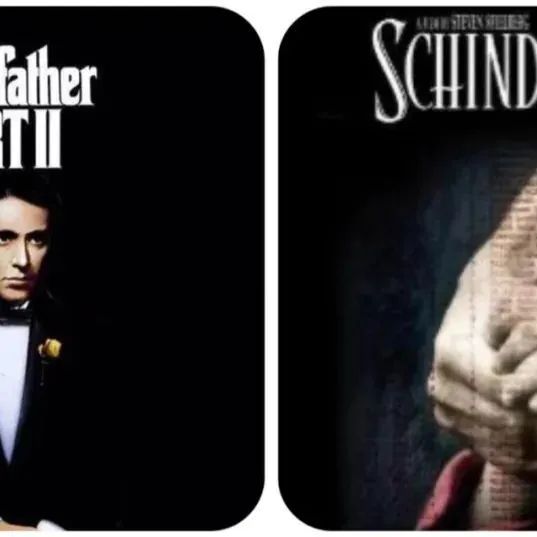Film Music 2 电影音乐2
(A clip from The Godfather, the theme played in the background)
“Parla Piu Piano,” or “Speak Softly Love,” is the most famous theme song from The Godfather. This piece is originally a song for love. The music appears in many scenes throughout the film. It does not only attempt to show the power of emotion; it also adequately portrays the profound motifs of human nature and fate, of how each character, no matter how hard they try, cannot escape its will. This piece cleverly reflects romance and fate through the unique utilization of structure, instrumentation, and tonality.
The first time this theme appears in The Godfather films is when Michael comes to Sicily. This theme is written in the classical ABA structure. The first A introduces the audience to the melody. The B section takes the music to a sudden rise in tension and dynamics, pushing it to its climax. The final A repeats the melody of the first A but with more vigor and strength. This complete ABA structure gives the music the necessary stability. It additionally allows the audience to be fully impacted by the melody and the climax by repeating the melody at least twice throughout the piece and gathering enough momentum for the climax to be impactful.
The theme mainly employs the strings, the piano, and the mandolin. The strings take on the main melody, producing a nostalgic, plain, emotional, and a bit bleak or lonely feeling. The strings set up the film's general tragic, beautiful tone, introducing a story sewn in romance and fate. The music corresponds with the scenes, dyeing them with such iridescence. During this time, the piano plays the accompaniment. The accompaniment is comprised of many supportive chords and harmonies. The solid, deep timbre of the piano adds texture and depth to the theme. The guitar and the mandolin join the accompaniment too. These two instruments’ chief role is to make the music sound exotic and dipped in Italian style, helping the audience to imagine the rolling mountains, vineyards, and oceans of the Mediterranean.
The tonality of this piece deserves attention. Popular versions of this piece are mainly written in C Minor. The utilization of a minor tonality imbues the music with sorrow, solemness, and much profoundness, which match the general motifs and tones of the film as mentioned above. In the B section, there is a slight change to a more major-sounding tonality, adding a sense of warmth, hope, and dimension. However, as the climax sets in, the music switches back to the initial C Minor, reminding the audience of the solemn motifs of romance and fate the film discusses.
Music for Schindler’s List is arguably the most striking masterpiece composed by John Williams. It attempts to show that the atrocities during the Holocaust must be remembered and reveals the power of hope and a good heart. In particular, it aims to show that the bright facet of human nature can transcend the boundaries of race, ideology, time, and hierarchy. Every ordinary individual can be kind, be wise in their ways. When John Williams watched the initial film, he told Steven Spielberg, the director: “You need a better composer than I am for this film,” to which Spielberg replied: “I know. But they’re all dead.” In the end, I believe Williams did compose a piece that matches the grandeur, depth, and messages of Schindler’s List.
The theme music for the film is the most renowned. For the instrumentation, John Williams decided to use the classical orchestra. The main melody is played by a solo violin and accompanied by strings and brass. One can describe the timbre of the violin as solemn but still soft. The turns between the notes are played in an elegant and emotionally vibrant way. The instrument perfectly delivers the sorrow and the slight hope related to the scenes and gist of the film. The theme music is written in D Minor, reinforcing the tragic and solemn sensations and complementing the general atmosphere of the film. However, the music is not entirely imbued with negativity. At the end of each phrase, there will always be a slight turn to a major chord, which delivers a force of hope and warmth amidst the solemness and coldness. Thus, from the subtle utilization of the tonality, one can see how Williams successfully weaved his music together with the messages from the film.
The tempo is relatively slow, and several ritardando markings are at the closing of phrases. The slow tempo assists the melody in expressing a continuous string of emotions and prolongs each note's effect on the audience’s heart. The slow tempo displays more textures and layers of the music more clearly, allowing the audience to immerse into the complexity and depth of the film fully. There is additionally a lot of repetition of the initial phrase. The repetition continuously emphasizes the theme and thus the sorrow and hope that are pertinent to it. Combined with the other musical elements, Williams composed a masterpiece that fits the film's overall mood and enhances and highlights the powerful messages that the producers want the audience to perceive.
To be continued…
WORKS CITED
Googlisme. “Le Parrain - Apollonia (Love Theme).” YouTube, 28 Feb. 2011, www.youtube.com/watch?v=JCOaI06zAvg&t=47s.
Universal Pictures. “Schindler’s List | ‘I Didn’t Do Enough.’” YouTube, 3 Dec. 2019, www.youtube.com/watch?v=W9vj2Wf57rQ.
"Parla Piu Piano"(“柔声倾诉”)是《教父》中最著名的主题曲,它原本是意大利西西里岛的一首浪漫爱情音乐。在《教父》中,它在多个场景中重复出现,它绝不仅仅展示的是浪漫情感的力量,更着重深入的是描绘人性与命运这一深刻主题,即每个角色无论如何努力挣扎,都无法逃脱命运的意志。这首曲子通过对结构、乐器与调性的独特利用,巧妙地反映了浪漫与命运的纠缠这个要旨。
这个主题在《教父》电影中第一次出现是在迈克尔来到西西里岛时。这个主题是以经典的ABA结构写成的。第一个A段向观众介绍主旋律的内容。B部分将音乐的张力和力量突然提升,逐渐将其推向高潮。最后的A段重复了第一个A段的旋律,但更富有活力与能量。这完整的ABA结构带给音乐必要的稳定性。此外,它还让听众充分受到旋律和乐曲高潮的影响。准确来讲,整个乐曲中至少重复了两次主旋律,同时在中段为高潮聚集了足够的动力,使之具有极强的冲击力。
该主题主要运用了弦乐、钢琴和曼陀林。弦乐承担了主要的旋律,奏出一种怀旧、朴素、充满思绪、凄凉而又孤独的感觉。弦乐奠定了影片悲凉却绝美的基调,引入了一个交织在浪漫和命运中的故事。音乐与场景相呼应,为场景染上斑斓的色彩。在这段乐曲中,钢琴演奏伴奏。伴奏是由许多支持性的和弦和谐音组成的。钢琴坚实、深沉的音色为主题增添了质感和深度。吉他和曼陀林也加入到伴奏中。这两种乐器的主要作用是使音乐听起来具有异国情调,浸透着意大利风格,帮助听众想象意大利的连绵山脉、葡萄园和无尽的汪洋。
这首曲子的调性也值得关注。这首曲子的流行版本主要用C小调写成。小调的使用使音乐充满了悲伤、庄严和深刻的内容,这与上述电影的基本主题和色调相吻合。在B部分,有一个轻微的变化,音乐转到了一个更像大调的调性,增添了一丝温暖、希望和立体质感。然而,随着高潮的到来,音乐又转回到最初的C小调,重新让观众注意影片所讨论的人性与命运的庄严主题。
《辛德勒的名单》的配乐可以说是约翰-威廉姆斯创作的最引人注目的杰作之一。这部电影不仅试图记载纳粹大屠杀期间所犯下的暴行,而且在悲剧的同时还揭示了希望和善良的力量。特别是,它旨在表明,人性的光明可以超越种族、意识形态、时间和阶级的界限,每个普通人都可以以自己的方式展现善良与智慧。当约翰-威廉姆斯看了最初的无配乐电影后,他告诉导演史蒂文-斯皮尔伯格:"你需要一个比我更好的作曲家来创作这部电影的电影音乐"。斯皮尔伯格回答说:"我知道,但他们都已经死了"。最后,我认为威廉姆斯确实创作了一首与《辛德勒的名单》宏伟、深刻主题相匹配的作品。
该片的主题音乐是最著名的。在乐器方面,约翰-威廉姆斯决定使用古典管弦乐队。主旋律由小提琴独奏,并由其他弦乐和铜管伴奏。小提琴的音色庄重而又柔和。音符之间的转折是以一种典雅和情感活跃的方式演奏的。该乐器完美地传递了与电影场景和要旨相关的悲伤与细微的希望。主题音乐用D小调写成,加强了悲剧和庄严感,衬托出电影的总体气氛。然而,音乐并没有完全被负面情绪所浸染。在每个乐句的结尾处,总会有一个轻微的转折,转为大调和弦,在庄严和冷漠中传递出希望和温暖的力量。因此,从调性的微妙利用中,人们可以看到威廉姆斯是如何成功地将他的音乐与电影中的信息编织在一起的。
这首曲子速度相对较慢,在乐句的结尾处有几个渐慢的标记。缓慢的速度有助于旋律表达出完整延绵的情感,延长每个音符在观众心中所激荡的效果。换句话说,缓慢速度的作用是以更清晰的方式展示音乐的更多纹理和层次,让观众完全沉浸在影片的复杂性和深度中。此外,最初的乐句也有很多重复。这种重复不断地创造出对主题以及与之相关的悲伤和希望的强调。与其他音乐元素相结合,威廉姆斯创作了一部代表作,不仅符合影片的整体情绪,而且还增强和突出了制片人希望观众感知的强大主旨。
未完待续...
- 本文标签: 原创
- 本文链接: http://www.jack-utopia.cn//article/398
- 版权声明: 本文由Jack原创发布,转载请遵循《署名-非商业性使用-相同方式共享 4.0 国际 (CC BY-NC-SA 4.0)》许可协议授权










